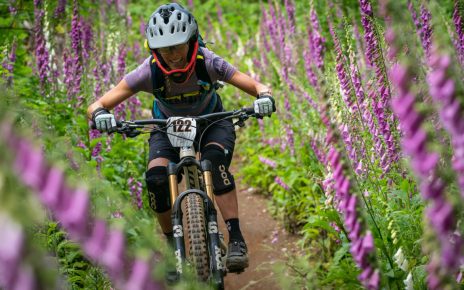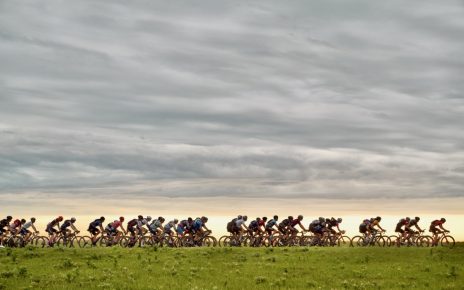We’re all used to the ‘mountain bike claw’ at the end of a long day of riding as we pry our semi-paralyzed hands from the grips. The feeling of being beaten up after a day of bike park battery is part and parcel of modern mountain biking, but just how much vibration are we getting through our handlebars? And is that safe for us in the long run?
A recent study from Edinburgh Napier University suggests that mountain bikers are experiencing more intense vibrations than a construction worker who has spent a day on a jackhammer. The study was carried out by Norco Factory Team mechanic, Lewis Kirkwood, as part of his Ph.D. He fitted accelerometers to the bars of two top-ten riders’ bikes at a round of the Scottish Enduro Series and the British Championships. These are tracks that have hosted EWS rounds in the past and represent a typical, elite-level enduro race.
The data returned suggested that vibration levels the mountain bikers were experiencing exceeded the safe recommended levels according to ISO standards. ISO is a body that creates standards covering 164 countries with the goal of ensuring products and services are safe, reliable and of good quality. ISO 5349 – 1:2001, which monitors human exposure to hand-transmitted vibration, caps vibrations at 5.0 ms^-2, but Lewis found mean values of 5.84ms^-2 on the riders he studied, as well as values topping out at 6.61ms^-2.
Before you panic, we don’t yet know if those standards are relevant to mountain biking. “Just because these numbers are over the arbitrary value that we label as being bad doesn’t mean that the riders can’t handle it,” says Kirkwood. “We’ve still got a long way to go but I think it is important to quantify it.” In the workplace, exposure to vibration has been linked it to musculoskeletal, neuromuscular, vascular and other types of pathologies such as hand-arm vibration syndrome.
We caught up with Lewis to talk about how the study came about, what it might mean for everyday riders, and how we can limit the vibrations we experience when riding.
 How did this study first come about?
How did this study first come about?
Lewis: We started out by looking at the physiological demands of enduro racing. We had 9 elite racers for a year, and one of the ways of measuring the demands of racing was using Catapults. Catapults are pretty basic GPS units that can start to look at braking and the distribution of speed on tracks, and they can tell you a lot about where the fast guys make their time.
With those, you can measure whole-body vibration and we saw some quite high values but the equipment didn’t meet the specifications to measure at the ISO standard. This led us on to realising that we needed to measure vibration in accordance with international guidelines to fit it in with all the other research out there. At the moment, mountain biking is on its own path with how you measure things so we had to bring it back in line with the standard, it had to fit in somewhere.
 Where do these standards come from? What industries are experiencing the most vibrations?
Where do these standards come from? What industries are experiencing the most vibrations?
Lewis: Construction, people that spend all day on jackhammers, lumberjacks, and joiners. The reason these guidelines are in place is that they’re seeing hand arm vibration syndrome, an irreversible pathology. You can get white fingers syndrome, peripheral circulation, and nervous problems and musculoskeletal problems. So, there’s a reason those guidelines are in place but we still don’t know very much about how they come about and it’s different for everyone. Some people can experience more vibration and be fine and some people can experience less vibration and not be ok. It’s still early days but you have to put a number on it at some point.
 Are there other reasons vibrations are important for mountain bikers?
Are there other reasons vibrations are important for mountain bikers?
Lewis: The more vibration you expose yourself to, eventually it’s going to limit your grip strength. Vibration stimulates muscle and it makes the muscle tense, which is why you get arm pump because your muscle doesn’t relax and it cuts off the blood flow.
My director of studies, Professor Geraint Florida-James, did a study at Fort William and you can lose around about 30% grip strength in one run top to bottom. Eventually, you’ll hit a big hole and you can’t hold on or you lose your posture. It’s all energy; it has to be dissipated somewhere before it gets to your head. The more you can limit it at your hands, the faster you’re going to go but keeping that control and performance is the key part.
Lewis: We also had models for how much training the guys were doing and mountain bikers, going by heart rate, were doing roughly half of what the road riders were but they were still getting the same improvements in physiological parameters. You have to provide the same stimulus to get the same outcome, so we were obviously missing half the measurements. In mountain biking there’s a lot more involved in terms of vibration, shocks, riding through holes and all of that stuff. That was something that pointed us towards vibration being a missing training load in mountain biking.
 Should elite and everyday mountain bikers be worried about vibrations?
Should elite and everyday mountain bikers be worried about vibrations?
Lewis: Well, we don’t want to cause panic with anyone and actually I’ve only got a hardtail so I don’t want the warriors to come and eat me up for being some sort of fear monger, but it’s concerning. It’s at the point where we don’t know what happens if we keep doing this for years and years. We don’t have mountain bikers that have grown really old yet.
As I grow up, I want to be healthy but the consideration for me is that I’m going to ride mountain bikes whether or not it’s going to be harmful because I like riding bikes. We believe there are ways of optimising the design of components such as handlebars, grips or even gloves, tyres and spokes, and if we can look at ways to minimize vibration while still keeping the performance then that has to be a good thing.
Just because these numbers are over the arbitrary value that we label as being bad doesn’t mean that the riders can’t handle it. We’ve still got a long way to go but I think it is important to quantify it because if you can’t do it reliably and in a valid way then how do you know if one handlebar is better than the other?
 So what’s next for you and this study?
So what’s next for you and this study?
Lewis: Professor Florida-James has just secured £19 million funding for an Innovation Centre and a bike park in Innerleithen with Edinburgh Napier University and with the Mountain Bike Centre of Scotland, which is a pretty massive deal.
This is just scratching the surface with handlebar vibration. This was to prove that we could do it, then with the Innovation Centre we can test different things. So if you had a component manufacturer with different layups of carbon handlebars and they wanted to know which was better in the field then we can put an actual number on it to reliably measure it. Then you go into seatposts, and frame material and spoke tension and that’s what I want to do more of.
Lewis: It gets really interesting when you can measure it and then measure the response from the body too. At Napier, we have a big physiology department where we can take blood from people so we can link up vibrations doses and changes in the blood to see if there is a relationship with things like osteo-arthritis and all the other nasty pathologies that potentially go with vibration exposure. It has opened up more questions than it’s answered at the moment!
The key thing I wanted to say is I’m not trying to scare people away from riding bikes by any means, it’s just something that we’ve realised is potentially going to be an issue and to address it. You see products coming out all the time that flex for comfort and then other times it’s all stiffness and strength. Ultimately we can measure these things and ultimately we would want to work with companies to develop such products to find the best balance.
The full study can be found here.



